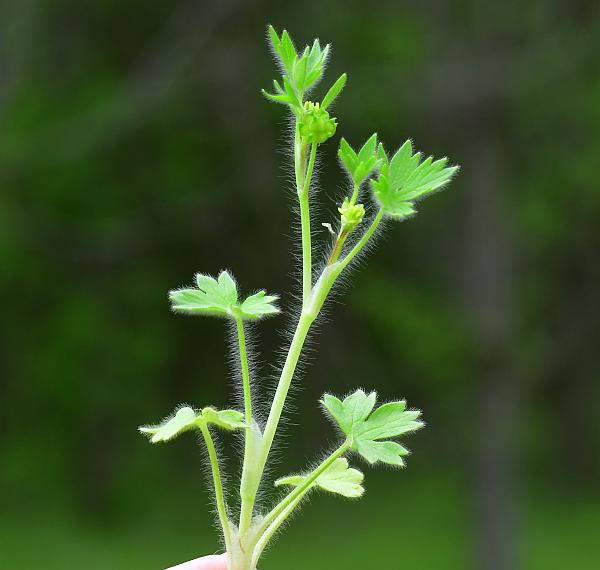Ranunculus parviflorus L.
Stickseed Crowfoot

Introduced
CC = *
CW = 0
MOC = 15
© SRTurner
Ranunculus parviflorus L.Stickseed Crowfoot | |
 |
Introduced CC = * CW = 0 MOC = 15 |
© SRTurner |
|
Family - Ranunculaceae Habit - Annual forb, the roots fibrous and not tuberous.
Stems - Weakly ascending to erect, to 30 cm, not rooting at the lower nodes, multiple from the base, branching, moderately to densely pubescent with fine, spreading hairs.
Leaves - Basal and alternate, petiolate. Petioles pubescent as stem, sheathing at the base. Basal leaves with the blade 1.5-3.2 cm long, 1.0-2.4 cm wide, heart-shaped, kidney-shaped, or semicircular, simple, the base shallowly to deeply cordate or less commonly broadly rounded, the lobes sometimes again 3-lobed, the lobes more or less rounded at the tip, the margins otherwise entire or sharply toothed. Stem leaves progressively and less divided from the stem base to tip, mostly short-petiolate or sessile.
Inflorescence - Single axillary flower from the base of the newest leaves, flowers often obscured by the larger leaves of the plant. Flowers sessile at first but quickly becoming pedunculate. Peduncle to 2.5 cm in fruit, villous, erect.
Flowers - Sepals 5, 1.5-2.0 mm long, reflexed from the base but lacking a transverse fold, more or less plane. Petals 1-5 or absent, when present 1.1-1.8 mm long, 0.2-0.7 mm wide, narrowly obovate to narrowly oblong-obovate, shorter than the sepals, yellow, glabrous. Style present. Stamens about 10, erect, from the base of the carpels, clavate. Anthers yellow, 1 mm long. Receptacle naked. Carpels compressed, antrorse puberulent in the center.
Fruits - Head of achenes 3-5 mm long at maturity, more or less globose, the receptacle glabrous. Achenes 1.7-2.0 mm long, the dorsal margin bluntly thickened, the wall thick, the lateral faces covered with hooked hairs, the beak flattened, triangular, strongly curved or hooked.
Flowering - March - June. Habitat - Upland prairies, pastures, ditches, fields, lawns, open disturbed areas. Origin - Native to Europe. Lookalikes - None close. Other info. - This little introduced species can be found in a handful of Missouri counties, predominantly along the southern border of the state. Beyond Missouri its range extends largely southward and eastward, with additional populations occurring near the West Coast. It is easily identified by its minute flowers (which is the meaning of the Latin term parviflorus), and hairy stems. Another good character to look for is the covering of hooked hairs on the faces of the achenes. These are very small and difficult to see without a hand lens. Photographs taken in Brown Summit, NC., 4-12-03, and off Lee Rd 54, Auburn, AL., 5-14-05 (DETenaglia); also at Riverfront Park, Washington, Franklin County, MO, 3-26-2021 and 4-16-2021 (SRTurner). |